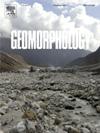Denudation asymmetries and drainage divide migration: Insights into the evolution of the Devonian Escarpment in Paraná, Brazil
IF 3.1
2区 地球科学
Q2 GEOGRAPHY, PHYSICAL
引用次数: 0
Abstract
The evolution of passive margin escarpments is governed by the interplay of erosion, drainage divide migration, and landscape development. This study examines the Devonian Escarpment and Paranapiacaba Range in Paraná, Brazil, using geomorphic indices, morphometric analyses, and cosmogenic nuclides (10Be and 26Al) to elucidate these processes. Maximum denudation rates range from 4.3 ± 0.4 to 18.3 ± 1.4 m Myr−1, with the highest values in the Upper Ribeira Valley (weighted mean: 10.0 ± 0.3 m Myr−1) and the lowest on the reverse side of the Escarpment Plateau (weighted mean: 5.8 ± 0.2 m Myr−1). Apparent burial durations vary from 0.2 ± 0.1 to 1.5 ± 0.8 Myr, with significant Al-Be depletion (up to 69 %) observed across most watersheds, reflecting complex sediment exposure and storage histories. Divide migration rates are lower than 335 ± 58 m Myr−1, indicating active basin reorganization driven by lithological, structural, and climatic controls. These findings provide a quantitative framework for understanding long-term landscape evolution and passive margin escarpment dynamics in tropical environments.
剥蚀不对称和排水划分迁移:对巴西帕拉南泥盆纪悬崖演化的洞察
被动边缘悬崖的演化受侵蚀、水系迁移和景观发展等因素的共同作用。本研究利用地貌指数、形态计量学分析和宇宙成因核素(10Be和26Al)来阐明巴西paranapapiacaba山脉的泥盆纪陡坡和paranapapiacaba山脉的演化过程。最大剥蚀率范围为4.3±0.4 ~ 18.3±1.4 m Myr−1,其中上里贝拉河谷剥蚀率最高(加权平均值为10.0±0.3 m Myr−1),陡崖高原反侧剥蚀率最低(加权平均值为5.8±0.2 m Myr−1)。表观埋藏时间在0.2±0.1至1.5±0.8迈瑞之间变化,在大多数流域观测到显著的Al-Be损耗(高达69%),反映了复杂的沉积物暴露和储存历史。分区迁移速率低于335±58 m Myr−1,表明受岩性、构造和气候控制的盆地活跃重组。这些发现为理解热带环境的长期景观演变和被动边缘悬崖动力学提供了定量框架。
本文章由计算机程序翻译,如有差异,请以英文原文为准。
求助全文
约1分钟内获得全文
求助全文
来源期刊

Geomorphology
地学-地球科学综合
CiteScore
8.00
自引率
10.30%
发文量
309
审稿时长
3.4 months
期刊介绍:
Our journal''s scope includes geomorphic themes of: tectonics and regional structure; glacial processes and landforms; fluvial sequences, Quaternary environmental change and dating; fluvial processes and landforms; mass movement, slopes and periglacial processes; hillslopes and soil erosion; weathering, karst and soils; aeolian processes and landforms, coastal dunes and arid environments; coastal and marine processes, estuaries and lakes; modelling, theoretical and quantitative geomorphology; DEM, GIS and remote sensing methods and applications; hazards, applied and planetary geomorphology; and volcanics.
 求助内容:
求助内容: 应助结果提醒方式:
应助结果提醒方式:


